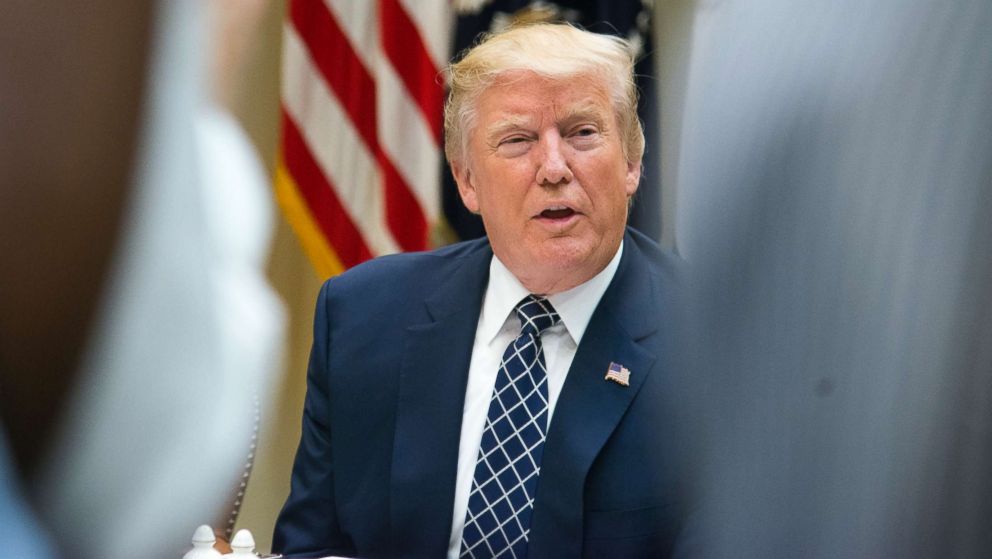A midterm preference for Democrats, but without anti-Trump motivation (POLL)
— -- A majority of Americans polled prefer to see the next Congress controlled by the Democrats to counter President Donald Trump rather than by the Republicans to support him — but without the level of anti-Trump motivation the opposition party may be banking on.
Despite Trump’s historically low approval rating, opposition to him does not produce appreciably more 2018 voting intention than support for him does, the latest ABC News/Washington Post poll found. That’s a challenge for Democrats because their supporters’ midterm turnout typically is low.
See PDF with full results here.
There is a Democratic preference: Among all surveyed adults, 53 percent say they’d prefer to see the Democrats take control of Congress “to act as a check on Trump,” versus 35 percent who’d like to see the GOP retain control “to support Trump’s agenda.” That said, among registered voters, it’s a 52-38 percent split, and among likely voters, 50-41 percent — the Democratic margin drawing in from 18 to 14 to 9 points as voting likelihood increases.
Moreover, 51 percent of polled registered voters say Trump won’t be a factor in their votes for Congress. The rest split closely between saying they’d vote to support Trump (20 percent) or to oppose him (24 percent) — a nonsignificant gap.
The division is narrower than in the past, further indicating no outsize impact of Trump’s unpopularity at this point. Before the 2014 midterms, surveyed registered voters said they’d cast their vote to oppose rather than support Barack Obama by a 10-point margin, and the gap against George W. Bush was 14 points in November 2006, compared with the scant 4-point difference today.
Neither side has a meaningful edge in enthusiasm: 84 percent of anti-Trump registered voters polled say it’s extremely or very important to them to vote to oppose him the midterms, and 82 percent of pro-Trump registered voters are as strongly committed to supporting him.
There’s also little difference between potential new midterm voters — those who say they’ll vote in 2018 but didn’t in 2014 — and off-year veterans. A fifth of surveyed potential new voters say they’d vote to support Trump, while 28 percent say they’d vote to oppose him; it’s 22 and 24 percent, respectively, among registered return voters.
Naturally, intention to vote to support Trump peaks among those in his party in this poll, produced for ABC by Langer Research Associates. Fifty-two percent of registered Republicans say they’ll vote to back up the president, while a smaller share of registered Democrats, 41 percent, say they’ll vote to oppose him. Independents, for their part, are most likely to say Trump won’t be a factor in their vote: 62 percent. Among the rest, slightly more are in opposition than in support, 22 versus 13 percent.
Control of Congress
In the question on control of Congress, registered partisans nearly unanimously back their respective parties, leaving the result driven by independents: Half prefer Democratic control of Congress; 36 percent, Republican.
Among white registered voters, men without college degrees — some of Trump’s strongest backers in the 2016 election — prefer Republican control, 60 versus 34 percent. By contrast, among white women with college degrees, it’s the reverse — 59 versus 35 percent for Democratic control.
Democratic control wins only a slight edge among polled returning voters, 49 versus 41 percent, while potential new voters prefer it more than 2 to 1: 64 versus 30 percent. That reflects the fact that new potential voters are younger and more likely to be nonwhite — two groups that consistently lean Democratic. And it underscores the Democratic Party’s need to boost turnout in these groups.
That may be a challenge. As previously reported, a majority of Americans see the Democratic Party as “just standing against Trump” rather than presenting a coherent alternative — a stance that may not be enough to get voters to the polls next year. Results aren’t much better among young voters and nonwhites — meaning that even in its base groups, the Democrats are struggling to present a positive agenda independent of their opposition to Trump.
Methodology
This ABC News/Washington Post poll was conducted by landline and cellular telephone July 10 to 13, 2017, in English and Spanish, among a random national sample of 1,001 adults. Results have a margin of sampling error of 3.5 points, including the design effect, for the full sample, and 4.0 points for registered voters. Partisan divisions are 35-23-35 percent, Democrats-Republicans-independents, for the full sample, and 37-25-31 percent for registered voters.
The survey was produced for ABC News by Langer Research Associates of New York City, with sampling, data collection and tabulation by Abt Associates of Cambridge, Massachusetts. See details on the survey’s methodology here.




